Statistics NZ’s population estimates and business employee numbers data has just been updated for 2020 and here’s a quick summary of them in relation to Auckland and the city centre.
Population
Plenty of milestones were reached in the latest population estimates. Auckland’s population has surpassed 1.7 million, a 2.2% increase and keeping growth in the region at a slightly higher rate than the rest of the country combined – however, a number of regions saw higher percentage growth with the Bay of Plenty having the highest rate of growth at 2.8%. NZ as a whole also passed the 5 million people mark and means that over a third (33.8%) of the entire country’s population lives in the region.
It’s also useful to look back over a slightly longer time period and so over the last decade our population has grown by 278,000 for an annual growth rate of 1.8%.
Though interestingly and somewhat unusually for Auckland, this growth is at the low end of what was projected.
Given that COVID is likely to keep immigration levels lower for some time, the low projection must surely now be the most likely scenario to play out over the coming decade.
Looking at the city centre, another milestone was reached with now more than 40,000 people living there. As you can see there has been a substantial and sustained growth in city centre population and means it is now about the size of Whanganui. This is one of the key reasons we need to be improving safety and amenity in the city centre.
Employment
Employment data is as of February so is perfectly timed to see how things were prior to COVID. Stats also now have 20 years worth of data. Within the Auckland region reached just 807,000 jobs, a 1% increase on 2019. That figure is also up nearly 200,000 on a decade ago, which was at its low point from the GFC, and up nearly 300,000 the year 2000.
Around 199,000 (25%) of those jobs are in the central area with 124,000 of those jobs (15%) in the city centre itself and a further almost 75,000 (9%) jobs in the city fringe. Job growth in the city and fringe has increased at a slightly faster rate than the region however the overall percentage has remained around 24% for most of the last two decades.
The city and fringe areas included in the numbers above are shown below
Only a quarter of the jobs in the region being in the central area might not seem like much, and it is small compared to many other cities, but it is still the single biggest employment area in the region. To put the employment numbers in perspective, the massive Onehunga – Penrose – Mt Wellington – Otahuhu commercial area combined has about 69,000 jobs, East Tamaki has about 38,000, Manukau around 36,000, Albany & North Harbour around 34,000 and the airport & industrial area to the north has 30,000. That’s a combined 206,000 jobs so almost identical to the central city.
As mentioned the percentage of jobs in the centre is low compared to other cities Even just compared to looking at Wellington, which has about 41% of all jobs in the region in and around its central city – an important contributor towards its comparatively higher level of public transport use.
Here’s how the total number in the city and fringe compares to those similar areas of Wellington and Christchurch – with the earthquake impact clearly being seen.
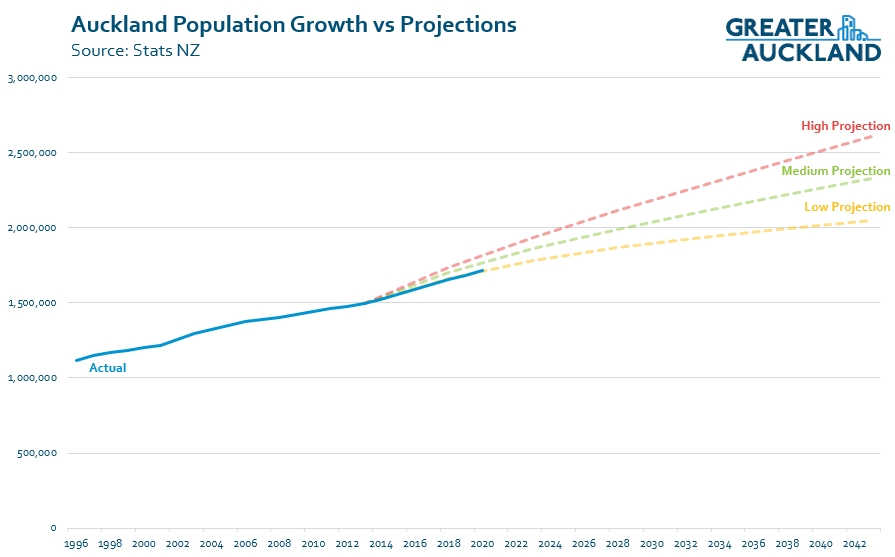
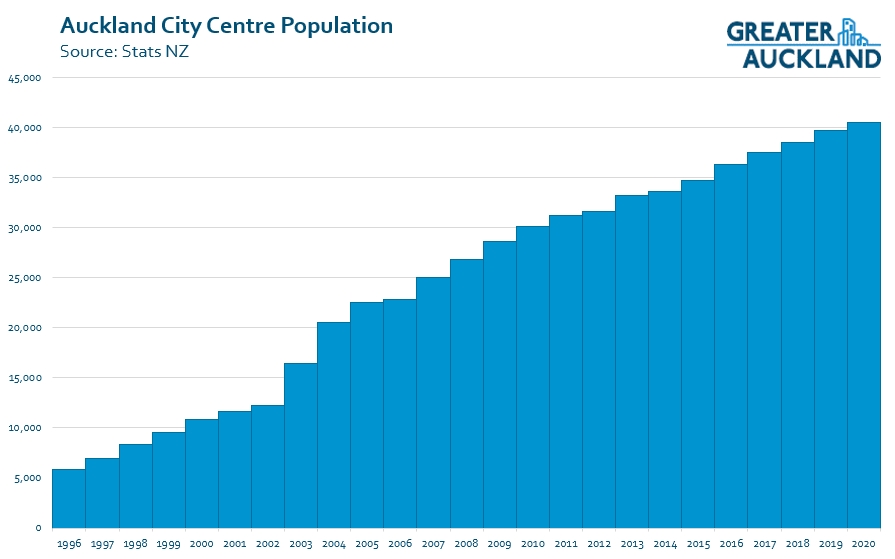
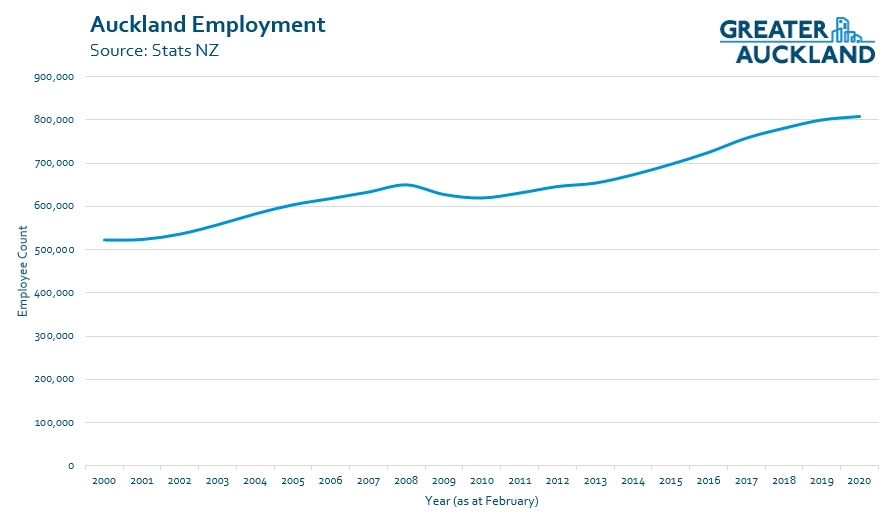
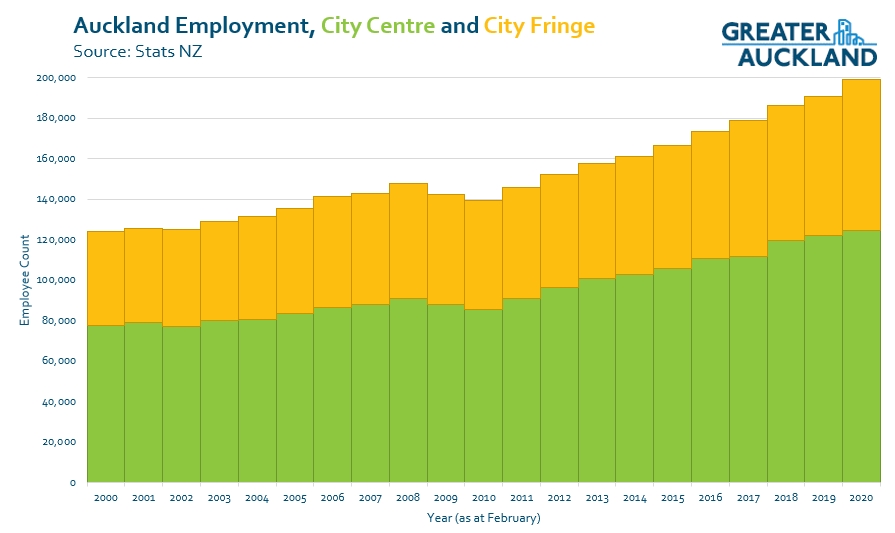
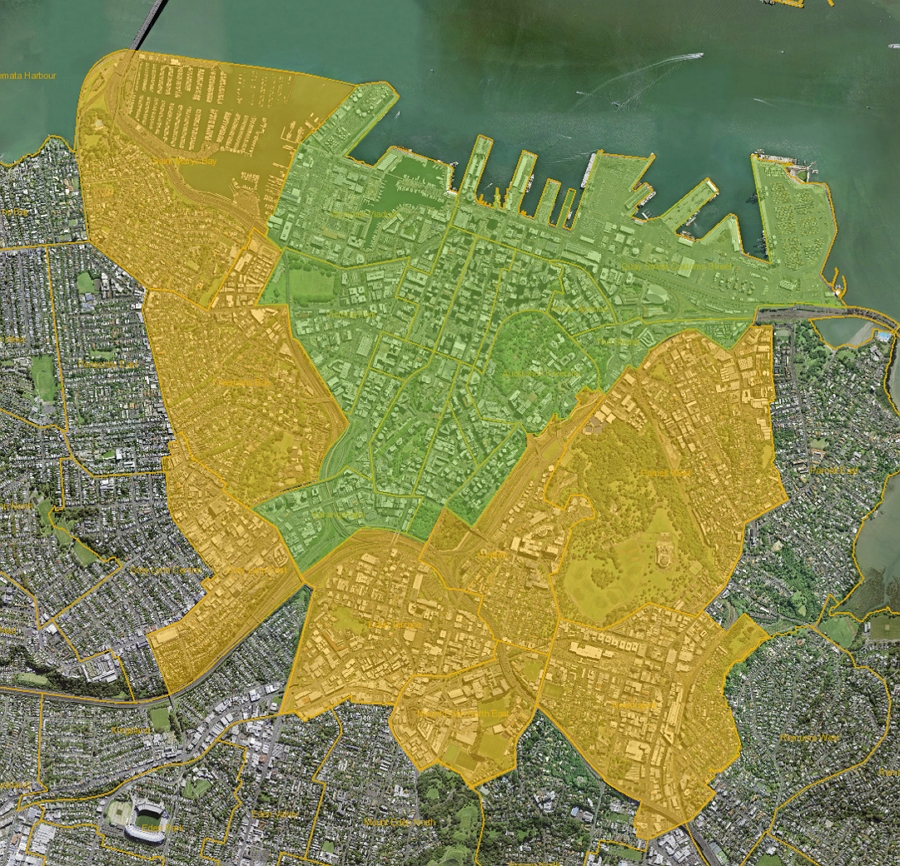
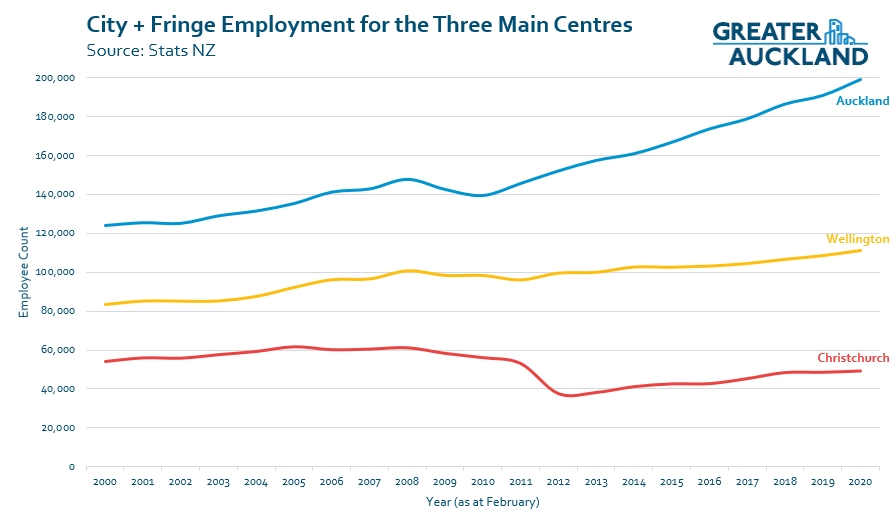

 Processing...
Processing...
Can anyone add more detail on central city population growth early 2000s, like type of apartment being built around turn on the century that accommodated this population increase?
And should there have been a stronger correlation between central city population growth and central city employment growth?
From memory most around then were small aka “shoe-box” apartments aimed as investor rentals for the burgeoning international student market. A lot of new apartment buildings were constructed in that period having been designed specifically to cater for this market. I think that is why there was a such a big jump.
The council changed the rules of minimum apartment sizes in 2005 to outlaw the shoe-box apartments as it became clear that developers had often taken the mickey out of the rules. As was predicted would be the case when council first allowed the smaller sized apartments.
As for inner city living and employment – as a lot of the historic growth has been in student accommodation, the link between CBD living and employment in the CBD is less direct.
It is only more recently that inner city living for those not just students has become an attractive option.
I recall from Matts past posts on the journey to work data from the 2013 census that showed many people who lived in the CBD on Census day 2013 commuted out to other areas of the city – so didn’t “live and work” in the same place.
I don’t recall seeing a 2018 Journey to work analysis, may have missed it.
However, the 2013 Census only counted “travel for work purposes” whereas 2018 recorded travel for work and for education purposes. So the 2 sets of data may not be directly comparable in any case. Given the 2018 census will have captured a lot more of the actual journeys than 2013 ever did.
Still allowing people to live [& not just work] in the CBD at all was a big change in planning rules – prior to I think the early ’90s Auckland City Council as it was then, actively discouraged most forms of inner city living. Preferring to (p)reserve the buildings for offices not apartments.
So we’ve come some of the way towards a balanced CBD, got a long way to go though.
Dont we kind of want these “shoe-box” apartments? I have lived in one in the past and wouldn’t mind it again so long as the building was nice. Downtown there are parks and open spaces, and soon to be way more pedestrian space so you get out plenty. The biggest detractor to apartment living in this country is the idea of it and convincing people to, so if the demand for super dense apartment living is there, isn’t that something we want to encourage a bit?
https://www.theguardian.com/cities/gallery/2017/jun/07/boxed-life-inside-hong-kong-coffin-cubicles-cage-homes-in-pictures
The toilet in the kitchen could be handy.
I agree Jack. I live in a small place and share with other people. Living is easy, I have a view, close to library, shops, park, station and handy to the city.
When travelling to Papakura I look out and see 1000’s of stand alone, look alike houses stretching to the hills. I don’t think they are attractive. They are closely packed with high coverage of concrete for several cars to park. They have minimal or no garden. The double garage is used for storage or for a boarder to help pay for all the commuting
Those shoe boxes saved the city centre from being a dead central business district.
While some people baulk at the idea of living in a 30m2 studio apartment in the city centre, for the target market, the alternative is living in a 12m2 bedroom of an old bungalow, along with five other people sharing a single kitchen and bathroom down the end of the hall.
@JFamilton “They have minimal or no garden.”
Good point. Part of the “cultural” perception of living in the suburbs is house AND garden. But that kind of “backyard” living doesn’t existing in a subdivded city.
@JFamilton The stupid thing is, these sections are still quite large. I quickly measured some smaller ones on Google Earth, coming in at around 300m². Most are larger. And still, you barely get any space outside.
On a lot this large, you can build, say, a 2 or 3 storey house on a 80m² footprint, and you will have plenty of space left to run that lawnmower.
Maybe kiwis like single storey homes better than their barbecues.
We are building more apartments close to stations.
There is now a choice and many are choosing apartments over long expensive commues
I think the thing is the size of “shoe-box” apartments is/was conflated with the quality of their build and location. Ie near the motorway/Nelson/Hobson st. Especially the sound proofing between layers etc I would guess. In any case it was quite new cultural shock for NZ to accept these but agree they fill a valid market if not for everyone.
How much sound proofing is there is in old houses converted into flats?
StatsNZ ran a competition to have a web tool for analysis of their 2018 Travel data. The winner was the “commuter waka”: https://commuter.waka.app/
If I use the above tool to select the city/fringe SA2s as in this post, this is the summary provided:
“7,146 people (21%) leave to 70 different areas for work or school. Newmarket, with 1,128 departures (3%) is the top destination outside of these 23 areas. To depart to work or school, people in these 23 areas most often walk or jog (47%).”
So 79% of city/fringe residents live and work/study within the area.
Filtering it to Workplace only, we get 25% of the residents leaving the area for work.
Education only, we get 12% of the residents leaving the area for study.
I reckon the correlation between population growth and employment is pretty good – the former has grown by 30,000 since 2000, the latter (for the city centre only) at a similar rate.
Out of city centre residents, there will be a few who work elsewhere (including me!) and a few who don’t have jobs (students etc), and but you could certainly say that a large share of the employment growth in the city centre has been met by the local population.
The link between city centre population and city centre employment has often been an inverse one. This is because people build apartments on a site when they know they can’t make money building offices. Population and employment are substitutes rather than complements in the city centre.
Actually that is over-stating it. There is a substitution going on by developers. For people living there they are complements but for the developer it is the effect of substitution.
I wonder how these job sector / area statistics are produced and their relevance to public transport. For example does the data accurately show jobs in central city for companies like Hawkins that have a central office and a large number of staff who work onsite.
Construction and trades are a large part of our economy and I don’t think they are reflected in these statistics.
Christchurch’s falling then stagnant central city employment figures over the last decade reflect;
1. The earthquakes that knocked down so many buildings, so that, 12.6% of the city centre land is off-street parking and only 23% is buildings.
2. A lack of investment in rapid transit in Canterbury compared to Wellington and Auckland.
3. Land banking in the form of an excessive amount of gravel car parking due to rates being too high on buildings and too low on land.
https://brendon-harre.medium.com/saving-christchurchs-cbd-dc0ea72d27e
Even though so much land is now off-street parking in Christchurch I still see complaints about “lack of parking” in the Christchurch CBD from people as a reason not to go there for either work or pleasure.
Yet the Riverside markets and Oxford Terrace areas do seem pretty busy despite the “lack of parking”?
As for lack of investment in Rapid (Public) Transport? [I see there has been lot of investment in rapid private transport aka motorway projects that never seem to finish and/or deliver sustained benefits, but that’s a different discussion for another day.]
As far as I can see the PT situation – rapid or not is actually a case of a complete lack of co-ordinated investment in public transport of any form.
Its not from a lack of desire by the Councils, but more down to the stupid regional council (yeah Wellington and Christchurch still have those sitting over the top of the councils), has had its head right up the Ministers of Transport and earthquake recovery arses over PT.
The local councils can’t do much about it still. The regional council plans the services, in a very hand wavery kind of way and expects the councils to “deliver” the bus lanes, and other infra to make the PT system work. Without any funding to make it so.
It certainly doesn’t help things to have this one sided provider/funder split. Nor that during the last National Government as one of its very first acts (prior to the ‘quakes even),
sacked/removedreplaced the elected regional council with its own appointed commissioners to run the show. Ostensibly it appears to keep the farmers happy over the rules around water and pollution rights in Canterbury.But its true that Wellington and Christchurch Regional councils make Auckland Transport look organised by comparison. But thats a mediocre comparison.
Given AT (and Auckland City) has had 10 years to get its shit together but hasn’t it is a “damning by faint praise” exercise at best.
We truly need a big reset in how PT is delivered within NZ – not just in Christchurch. but Christchurch is currently the warning to “do not do it like this”.
The debacle over how and when the Government would fund Aucklands CRL was an obvious Auckland example – who remembers that 25% employment growth and on track to exceed 20 million PT trips a year set of
hurdlestargets that Brownlee as Transport Minister imposed back in 2013 as a predicate to allow government funding to take place. Basically that was a way to kick the CRL can down the road to a future Government. Thankfully that foolhardy attempt was soon overcome and Auckland Council put its money where Brownlees mouth was and “kick started” the CRL project with its own money.And I think the people of Christchurch in particular, showed their complete and utter displeasure with Gerry Brownlee in particular, and many of his former National colleagues over their handling of the Christchurch rebuild progress over most of the last 10 years. They did so at the ballot box 2 weeks ago now.
But will Labour be able to make any real difference in the next 3 years?
One would expect so now they can government alone in everyway that matters.
But equally you also now half expect that “Covid-19” will become the de-facto 2020’s explanation for why so many things that are and were needed, have not in fact happened.
I can see already suggestions that CRL [and by extension any investments in any Public Transport projects within NZ] will yet become a white elephant as people depart the CBD areas for “less Covidy” ‘burbs or regions.
Time will tell on that one. I think like the “Great Russian Invasion of NZ” fears of 130 or so years ago it will never come to pass, but the follies it enables us to pursue in its name, will persist for a long time.
Covid being the demise of city centres is a narrative (excuse?) I too have heard recently. I doubt it will come to pass. Cities have survive, thrived even, over long periods of history despite far worse plagues and afflictions.
Higher rates on vacant land would marginally decrease land values but have no positive effect on the demand for office space. It’s the demand for office space which ultimately determines whether new office buildings are developed. Vertical construction is very expensive in NZ so office rentals rates need to be strong to warrant new office buildings being developed. The proportion of value tied up in land within an office tower is quite small compared to the value of the improvements, so the small downward effect of higher rates on land values won’t achieve anything I’m afraid.
Re the “demise of city centers”, I have seen some investment gurus proclaim the CBD will bounce back at the expense of small towns.
The general premise (in an AKL context) is that people fled to smaller towns because they could not afford where they wanted to live or did not want to spend half the day commuting on PT.
However in the move to a mixed-model – going into the office only twice a week – people will be prepared to compromise. They will live on the city fringe due to affordability and knowing the commute has been reduced by 60%. But they will still have access to the city center when they so desire (shopping, concerts, sports events, etc) for things that aren’t available in the smaller centers. Probably still means reduced footprints for those taking office leases in the CBD.
Time will tell, I guess.
Not surprising that Auckland’s population growth has been on the low side. House prices are too expensive for most by a long way. The boomers have made their capital gains and have sold up and moved to the likes of Tauranga, Northland, etc where they could get land and a house for half the price and have that capital for retirement etc.
if house prices weren’t enough, the congestion and things like water charges etc also put people off
City centre deserves to have its own public Urban primary and secondary school within walking distance. Without this people will just move out to suburb once they has kids.
Agree.
Current Primary options are Freemans Bay for students in the Hobson/Nelson apartment precinct, which is a walkable distance, though it’s through pedestrian-hostile environment. Parnell School is the primary in zone for children in the Beach Rd apartment precinct. It’s a ~2-3km walk, so not great.
Auckland Girls Grammar (walkable/good PT) and Western Springs College (good bus services along GNR) are the existing secondary options.
We really need to work on that pedestrian-hostile environment.
The Waitemata Local Board had a really good plan that they were working on, but it sounds like it has been scuppered by the emergency budget.
The last couple of weeks has seen cars parked two-abreast on the Union Street footpath, and kids and adults on foot walking into the moving traffic to get past. I was taking a photo of this, and a truck pulled up onto the footpath, waved me out of the way, then parked where I was standing to take the photo. It’s getting really hazardous.
Some of Auckland Transport’s plastic planter boxes on the footpath spaced to exclude cars but allow people on foot and scooter and bike and pram would be a quick, cheap solution.
Saw exactly this recurring issue posted on Twitter today
https://twitter.com/ludwigw/status/1323354427072208897
2 to 3 km is much further than the walk to school from many homes in the suburbs. I mean, damn, I have 2 primary schools within half that distance. And the CBD is much more hostile to pedestrians than the suburbs.
Also, that is half a dozen schools that are kind of reachable. How does that compare to Whanganui?